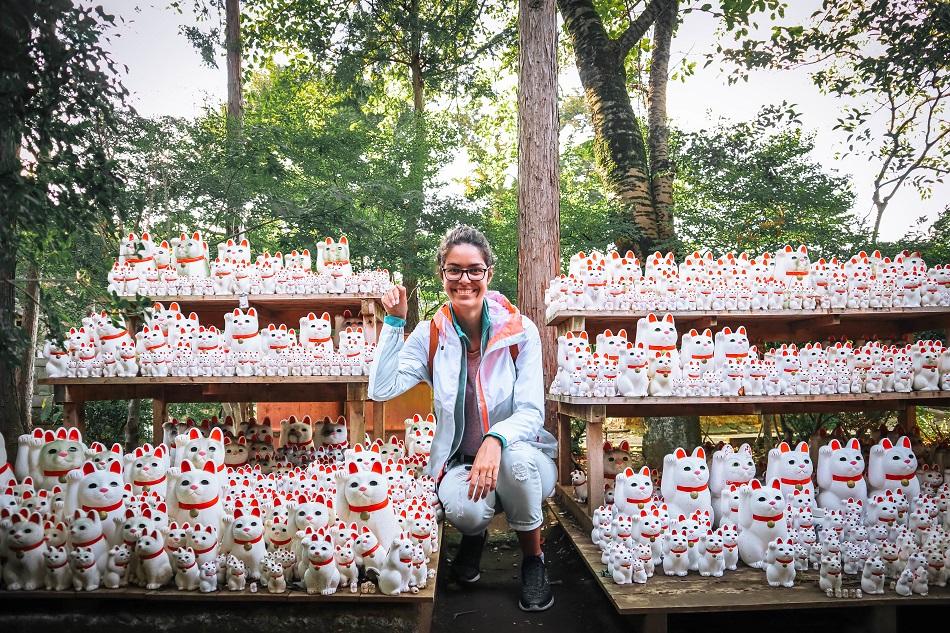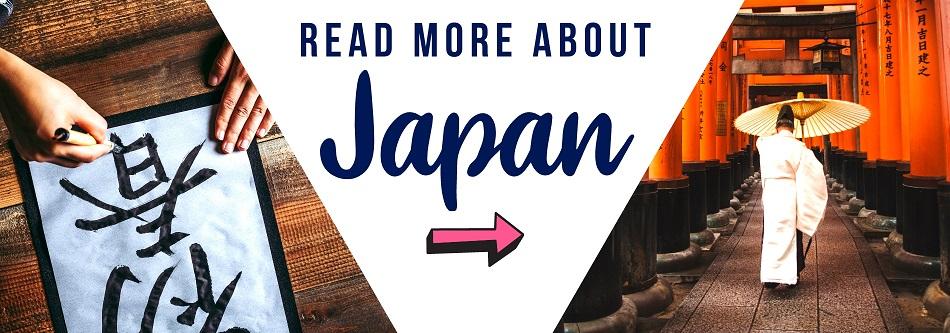I’ve seen many Buddhist temples during my one-a-half-year-trip around Asia but none as intriguing and different as Gotokuji Temple in Tokyo.
Considered to be the birthplace of maneki-neko, Gotokuji Temple is one of Tokyo’s hidden gems. Unlike other temples in Japan’s capital, you won’t find many tourists here. This temple is definitely worth a visit if you’re into quirky places.

Apart from its beautiful architecture, Tokyo’s Cat Temple is mostly known for the thousands of maneki-neko statues displayed in its garden. This is the reason why this temple has been also named “Tokyo’s Cat Shrine” or “Tokyo’s Cat Temple”.
In this guide, I’m going to share with you everything you need to know before visiting this incredible place. Let’s start with learning more about maneki-neko.
-> Are you looking for the perfect Japan itinerary? Click here!
1. What is maneki-neko?

The maneki-neko or the “beckoning cat” is a Japanese symbol which is believed to bring good luck to its owner. This cat figure acts like a talisman or lucky charm and is displayed at the entrance of shops, restaurants, and other businesses.
You’ll see these lucky cats in all tourist markets. Sometimes they are made out of ceramic, sometimes they are made out of plastic. Some maneki-neko work on batteries and one of their paws is slowly moving.
No time to read now? Pin it for later!



There are actually three types of maneki-neko. Some of them have their left paw raised, others have their right paw raised. There are even some figurines with both their paws raised. Below is the explanation:
- Left paw raised – attracts more customers (for businesses)
- Right paw raised – attracts more money (for homes)
- Both paws raised – attracts both money and customers

Originally, the maneki-neko is white. However, during the past years some variations were born. I’ll go into detail about their meaning below.
- White – good luck and good fortune
- Black – ward off evil
- Red – good health
- Pink – good relationships
The maneki-neko cats at Tokyo’s Cat Temple are all white. Be prepared for a unique sight because you’ll see thousands of lucky cats at Gotokuji Temple, coming in all shapes and sizes.
2. About Gotokuji Temple
Tokyo’s Lucky Cat Temple is anything but usual. There are thousands of statues but most of them are located left of the main hall. One interesting fact is that the lucky cat figurines from Tokyo’s Cat Shrine all have their right paw raised.
Other AWESOME things to do in Tokyo:

Locals come at the temple, buy a beckoning cat and make a wish. When their wish comes true, they return to the temple with the cat and leave it here as a sign of gratitude. This is why there are so many maneki-neko at Gotokuji Temple.
Apart from its unique statues, this temple is a quiet place, perfect to spend your evening away from the hustle and bustle of Tokyo. It’s quiet and if you’re lucky enough to visit it during spring, you’re in for a treat – the cherry blossoms!
Gotokuji Temple Legend

The legend says that during the Edo period, a lord from Hikone passed by a temple. A thunderstorm was approaching and the lord was saved by a cat inviting him to the temple. The cat raised one leg as if waving him to the temple.
Thankful for the cat’s deed, the lord repaired the temple and named it Gotoku Temple in 1697. When the cat died, a statue was made to remember this special cat. This is how maneki-neko was born.
Gotokuji Temple opening hours – 8 am – 6 pm
Gotokuji Temple entrance fee – FREE
3. What to do at Gotokuji Temple
Gotokuji Temple is a great example of beautiful Japanese architecture. Located in a quiet neighborhood and with a relaxed vibe, the temple is perfect for an evening escapade from Tokyo.
There are many more things to do at Gotokuji Temple apart from admiring the lucky cat figurines. Below are a few examples.
Buy a wooden ema plaque and omikuji

Buy an ema plaque from the Gotokuji Temple store and write down your wish. After that, hang it on the designated wall and wait for your wish to come true.
Omikuji are Japanese fortunes written on strips of paper. Pick an omikuji and see if you have a good or bad fortune. If you don’t know Japanese, ask the temple’s staff to help you read your omikuji. If it’s good, keep it! If not, tie the omikuji from one of the trees near the shop and leave your bad fortune behind.
Admire the Main Hall and the Three-Storey Pagoda

Take your time to explore the gardens of Gotokuji Temple and you’ll discover a beautiful Main Hall where locals pray and an incredible Three-Storey Pagoda rising toward the sun.
4. How to get to Gotokuji Temple
Getting to Gotokuji Temple is very easy if you choose public transport. Take the Odakyo Line from Shinjuku Station and disembark at Gotokuji Station. The ride will take around 30 minutes.
From the station, you’ll have to walk for around 10 minutes until the Lucky Cat Shrine. One thing you should remember is that the entrance to the temple is through the South Gate.
Good to know – If you’re planning to explore more of Japan, with a JR Pass you’ll get unlimited train rides across the country.

5. Where to stay in Tokyo
I’ve been searching for the best hotels in Tokyo for each budget. Here are my recommendations:
- Budget – Emblem Hostel – good location, gym, clean rooms, access to train/ subway
- Mid Budget – Hotel Rex – excellent location, included breakfast, modern & spacious rooms, awesome amenities
- Luxury – Ascot Tokyo – excellent location, beautiful pool, spacious & luxurious rooms, excellent staff, great value for money
If you’re planning a visit to Tokyo’s Lucky Cat Temple, I hope that this guide was helpful. Discovering Gotokuji Temple was an interesting experience and I loved how unique this place is. If you have any questions, don’t hesitate to let me know in the comments section below.
May the travel bug bite you!
